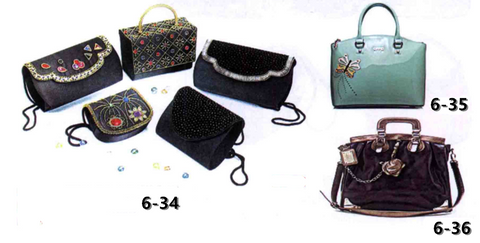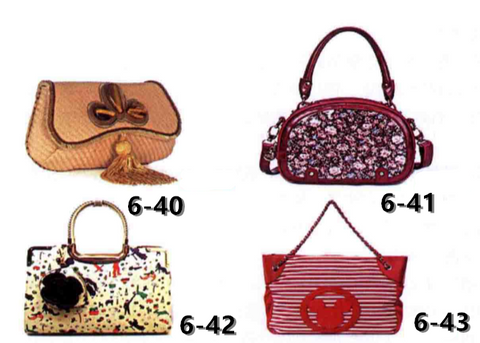The constituent elements of the pattern are the state of the pattern itself, and the decorative layout of the pattern on the luggage,such as best laptop backpack. Generally, the decorative layout of patterns on bags is divided into four types:
(1) Partial or small-scale block surface decoration on the wrapping surface is called "point-like composition";
(2) The elongated decoration on the edge or part of the luggage is called "linear composition";
(3) The "flower decoration" covering the entire surface of the luggage is called the "surface composition" form;
(4) The "comprehensive composition" form of the above three types of comprehensive applications. The above four decorative layout forms can be seen in the classic design performance from Figure 6-34.
(Ⅰ) Dot structure
The dot-like structure can easily become the focus of guiding the line of sight. It can add a sense of liveliness to the shape of the luggage and make a certain part more prominent and eye-catching. Pure decorative patterns, or certain accessories, buttons, bows, three-dimensional flowers, etc. can all be regarded as dots. The butterfly pattern shown in Fig. 6-35 can be regarded as a dot structure, which is a flat dot structure, while the one shown in Fig. 6-36 is a three-dimensional dot structure.
The flat points are attached to the surface of the bag, and the three-dimensional points are free from the outside of the bag, so a certain amount of support is needed to complete the point formation. In the bag shown in Figure 6-36, a three-dimensional dot-like structure is formed by the connection of the strap and the metal chain. Many student backpacks have dot-like structure too.

(Ⅱ) Linear composition
Linear composition refers to a form of composition that appears on the edge or a certain part of the bag in a relatively slender pattern. The line has the characteristics of making the viewer's line of sight move continuously along the linear direction. Therefore, the linear decoration will have a certain effect on the surface where it is located. It is usually used to emphasize the edge of a certain surface and adjust the width and straightness of the luggage.
Generally, linear pattern decorations are mostly two-sided continuous patterns or band-shaped grouped patterns, and the two continuous patterns have strict regularity and a clear sense of rhythm. Linear pattern decoration plays a very important role. First of all, linear pattern can play the role of highlighting the edge by drawing the edge. The edge part of the luggage is further emphasized through decorative reminders, and the edge contour is strengthened and defined.
This form of composition is conducive to strengthening the style and structure of the luggage, the pattern image is simple and beautiful, and the overall luggage appears delicate and precise. As shown in Figure 6-37. In the red bag design of Figure 6-38, the symmetrical positions of the bag fan are arranged neatly by the rivets to form a very clean linear decoration. Due to the unique decorative characteristics of the rivets, the linear decoration is very prominent and obvious.
(Ⅲ) Planar structure
The surface structure refers to the structure that is presented on the surface of the bag in the form of patterns covering the whole. There are many forms of surface structure. For example, uniform surface distribution refers to the natural application of tetragonal continuous patterns, individual patterns or grouped patterns to luggage decoration. Of course, there are also uneven surface composition forms.
In the actual design, the designer does not deliberately pursue the organization of the pattern itself to adapt to the structure, segmentation, and transition changes of the luggage, but pay more attention to the style and tone of the pattern to echo the characteristics of the luggage modeling. The surface composition can also adjust the expression style through the size and density of the constituent elements. The color dot surface composition pattern shown in Figure 6-39 is completed by the size and color changes of the decorative elements.

(Ⅳ) Comprehensive use of points, lines and surfaces
In fact, the comprehensive use of points, lines and surfaces is the key form of luggage pattern design. Whether it is an abstract pattern or a pattern that tends to be realistic, the concrete expression cannot be separated from the joint action of points, lines, and surfaces, which are the basic elements of the pattern. Points, lines, and surfaces have their own characteristics, which can form different visual perceptions. A point is a relative concept. There are areas of different sizes, and the same point can be transformed in different environments. The comprehensive use of points, lines, and areas can produce the following changes:
①Combination of dots and lines: In the form of dots and lines, dot decorations are usually the main body and play the role of the center of decoration on the bags, while linear decorations often appear as backgrounds, edges, and foils. As shown in Figure 6-40.
②Plane and line: The linear decoration in the form of surface and line surrounds the full flower pattern like a contour frame, forming a combination of line and surface, reflecting each other. The large area of complex and gorgeous is set off by the line decoration outline structure eye-catching and clear. As shown in Figure 6-41.
④ Surface with dots and lines: The general processing method of surface with dots and lines is to highlight dot and line decorations, and weaken the surface decorations to become foils or shading, as shown in Figure 6-43. Sometimes dot and linear decorations are made into three-dimensional shapes, which increase the distance from the surface decorations, thereby changing the complex planes into orderly levels.



